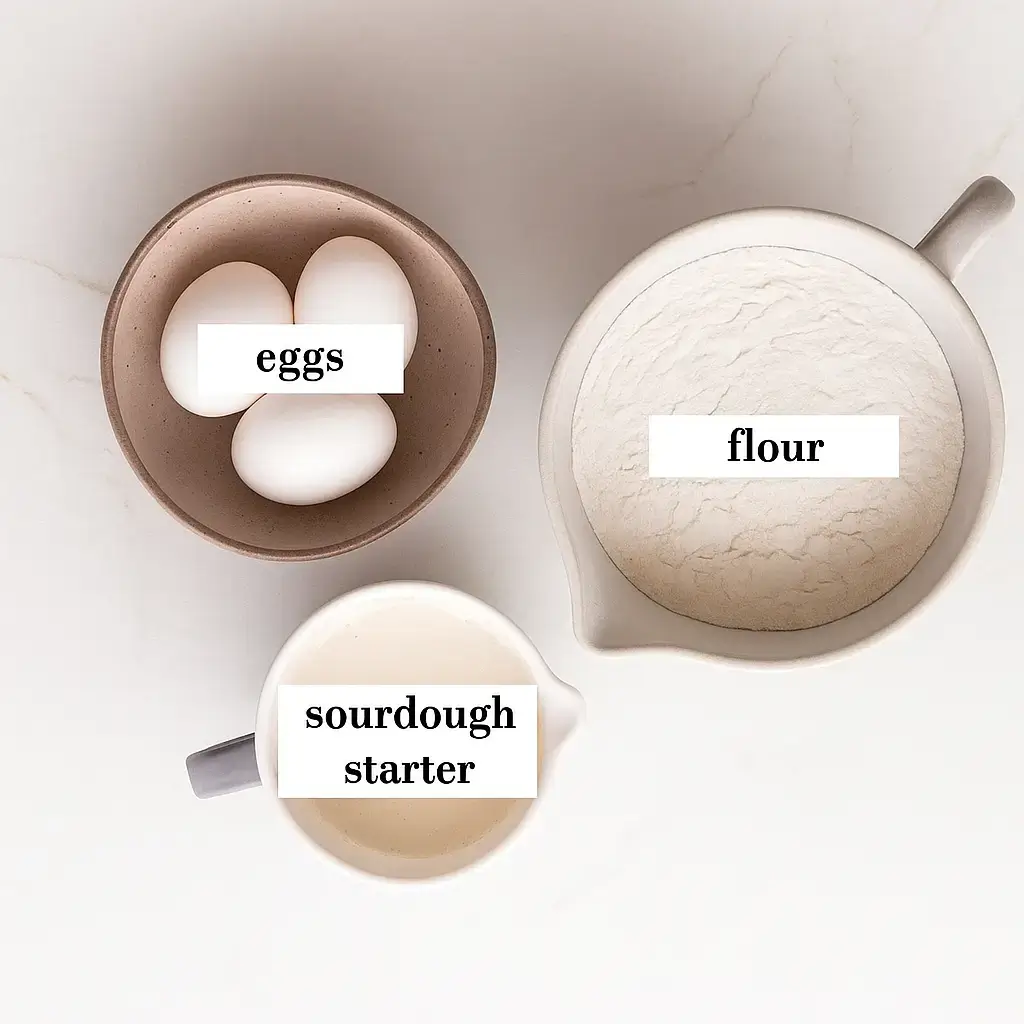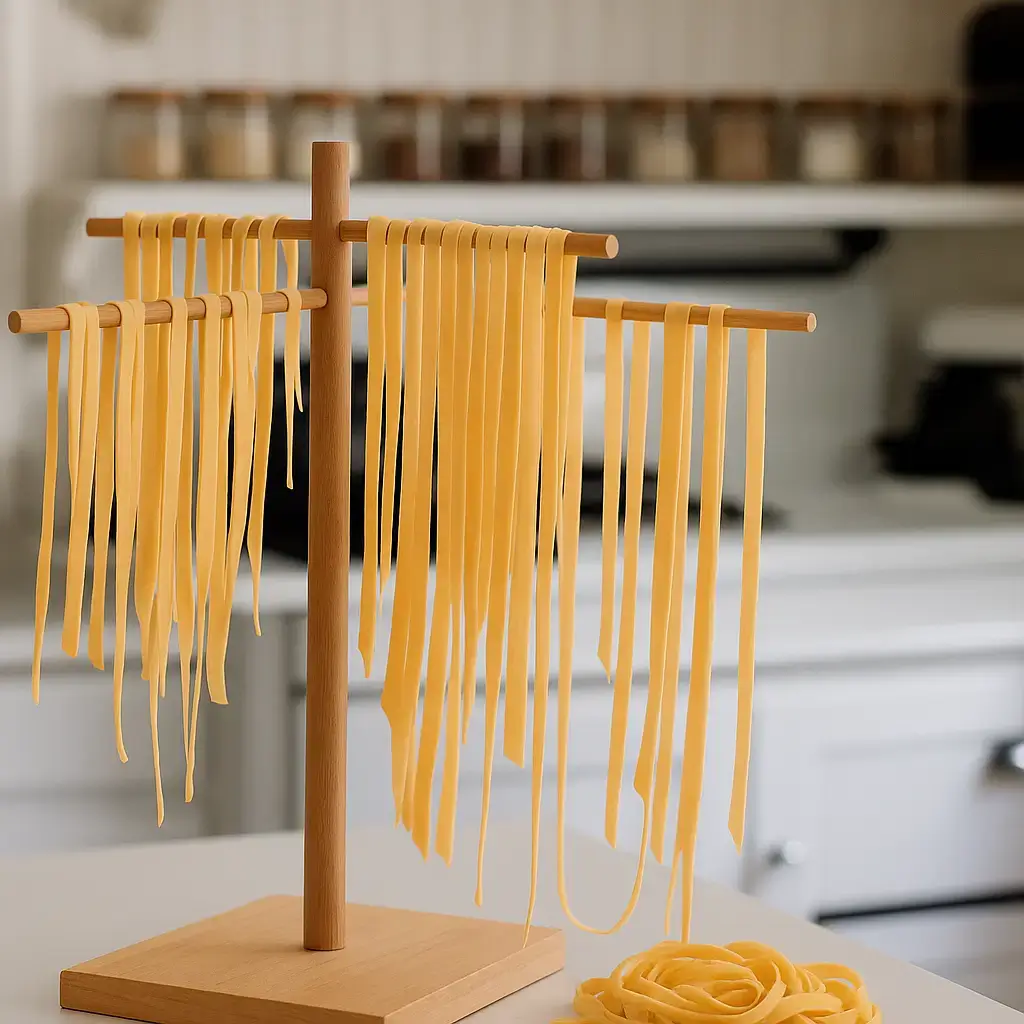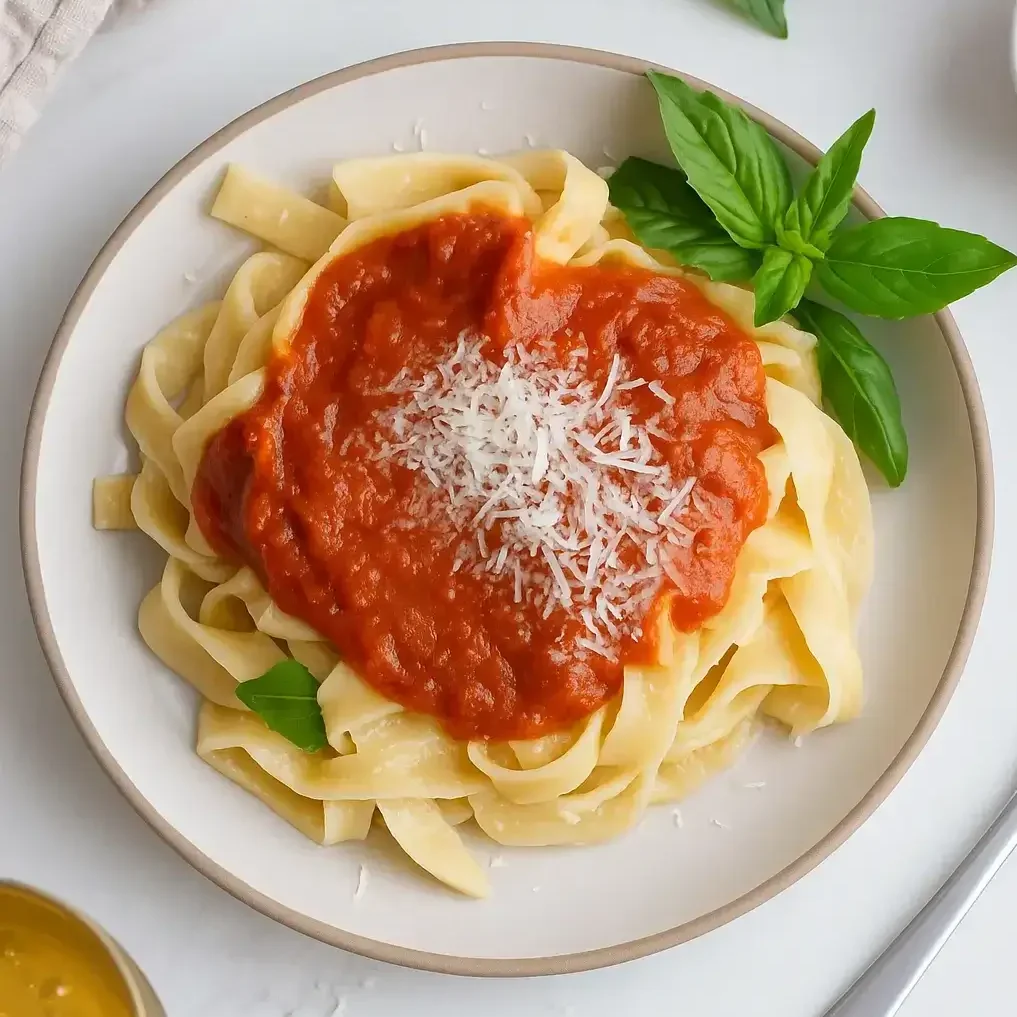If you’ve ever loved the tangy chew of sourdough bread and the hearty comfort of a plate of pasta, sourdough spaghetti might be your new obsession. Combining traditional pasta-making techniques with the gut-friendly benefits of sourdough fermentation, this pasta is a healthy, flavorful upgrade to your weeknight meals.
In this article, we’ll explore everything from what sourdough spaghetti is to how you can make it at home, why it’s considered a better option for digestion, and how it fits into various diets. We’ll also answer top FAQs like Is sourdough pasta healthier? and Can I use my starter in spaghetti dough?
Table of Contents
Table of Contents
What is Sourdough Spaghetti?
What Makes Sourdough Spaghetti Different from Regular Pasta?
Sourdough spaghetti is a type of pasta made using a natural sourdough starter instead of just flour and water. The key difference lies in the fermentation process, where wild yeasts and bacteria help break down the flour before it’s cooked. This pre-digestion improves not only the texture and flavor but also the health benefits of the spaghetti.
Unlike boxed pasta that’s dried and often stripped of nutrients, sourdough spaghetti is usually homemade or artisan-crafted, offering a deeper flavor, better chew, and enhanced nutritional profile.
Here’s a quick comparison:
| Feature | Sourdough Spaghetti | Traditional Spaghetti |
|---|---|---|
| Leavening | Wild yeast (starter) | No leavening agent |
| Fermentation Time | 4–12 hours or more | None |
| Flavor Profile | Tangy, rich | Neutral |
| Digestibility | Easier | Harder to digest |
| Gluten Structure | Weakened (gentler) | Fully intact |
The Role of Fermentation in Sourdough Pasta
Fermentation is the core of what makes sourdough spaghetti stand out. Through a slow, natural process, the sourdough starter begins breaking down gluten and phytic acid in the flour. This results in a more digestible pasta that’s easier on the gut and potentially better for people with gluten sensitivity—not celiac, but those with mild intolerance.
Also, fermentation releases beneficial organic acids like lactic acid, which help your body absorb more minerals from the grains.
This fermentation process also imparts that signature tangy flavor, giving your spaghetti a unique character that’s hard to replicate with traditional recipes.
Health Benefits of Sourdough Pasta
Is Sourdough Pasta Better for Digestion?
Yes, and here’s why: sourdough pasta undergoes a fermentation process that helps pre-digest the flour. This makes the final dish much easier on your gut. During fermentation, enzymes break down phytic acid—a compound in grains that blocks mineral absorption. The result? Better bioavailability of nutrients like iron, magnesium, and zinc.
Plus, the fermentation weakens the gluten structure, which means less bloating and inflammation for people with gluten sensitivity (but not those with celiac disease).
Sourdough also supports a healthier microbiome. The natural probiotics created during fermentation—though not all survive cooking—may still have a positive impact on gut health over time. It’s a small edge, but for health-conscious eaters, it adds up.
Nutritional Profile of Sourdough vs. Traditional Spaghetti
Here’s a head-to-head nutrition breakdown of 100g servings of cooked pasta (values may vary based on flour and starter):
| Nutrient | Sourdough Spaghetti | Traditional Spaghetti |
|---|---|---|
| Calories | 160–180 | 200–220 |
| Protein | 6–8g | 7g |
| Net Carbs | 30–35g | 40–45g |
| Fiber | 2–4g | 1–2g |
| Glycemic Index (GI) | Lower | Higher |
| Digestibility | Easier | Moderate |
| Fermentation Benefits | Yes | No |
Sourdough spaghetti typically scores lower on the glycemic index, meaning it won’t spike your blood sugar as sharply as conventional pasta. This makes it a smarter option for people managing diabetes or those watching their carb intake.
Looking for inspiration? Try these pasta swaps and high-fiber meals on our healthy 30-minute recipes blog.
Other Health Perks
- Longer satiety: Thanks to better fiber and fermentation, you feel full longer.
- Less processed: No commercial yeast, preservatives, or fillers.
- More minerals: Due to phytic acid breakdown, you absorb more nutrients per bite.
In short, sourdough spaghetti offers more than just taste—it supports your well-being from the inside out.
Can You Make Spaghetti with Sourdough Starter?
Using Sourdough Discard or Starter in Pasta Dough
Absolutely—you can use both active sourdough starter or discard to make sourdough spaghetti. The key is understanding how each works in the dough. An active starter (bubbly and fed) is best when you want a stronger rise and fermentation. Discard, though less potent, still adds flavor and acidity—perfect for that sourdough tang.
The starter acts as a natural leavening agent, but remember: pasta dough doesn’t need to rise like bread. Instead, the fermentation improves texture and digestibility.

Recommended Ratio:
- 1 cup flour
- ⅓ cup sourdough starter (active or discard)
- 1 egg or 3–4 tablespoons water (for vegan)
- ½ tsp salt
Pro Tip: Let your dough ferment for 4–8 hours at room temp or overnight in the fridge. This unlocks the nutritional and flavor benefits of sourdough.
Best Flour Combinations for Sourdough Spaghetti
Choosing the right flour makes all the difference. You’ll want a blend that balances protein strength, elasticity, and flavor. Here are popular options:
| Flour Type | Best For | Notes |
|---|---|---|
| Semolina Flour | Authentic Italian-style pasta | Rich in flavor and texture |
| All-Purpose Flour | Versatile and easy to handle | Great for first-timers |
| Whole Wheat Flour | High fiber and nutrients | More rustic taste, denser dough |
| 00 Flour (Tipo) | Ultra-smooth pasta texture | Soft and elastic, great with starter |
| Einkorn/Kamut/Spelt | Ancient grains, rich in minerals | Excellent sourdough compatibility |
You can also mix flours: Try 50% semolina + 50% all-purpose for a firm but flexible dough.
Don’t miss our upcoming guide to DIY fermented pasta kits—coming soon on 30minrecipes!
Whether you’re making spaghetti by hand or with a pasta machine, using sourdough starter elevates your dough’s structure and taste. It’s more artisanal, more digestible, and more satisfying.
Homemade Sourdough Spaghetti Recipe
Step-by-Step Sourdough Spaghetti Recipe (with Starter or Discard)
Making sourdough spaghetti at home is easier than you think. With just three basic ingredients and your favorite starter—fed or discard—you can whip up a pasta that’s healthier, heartier, and more flavorful than anything store-bought.
You can opt for a quick version or a long ferment for deeper flavor and improved digestibility.
Print
Sourdough Spaghetti
- Total Time: 1 hour 5 minutes
- Yield: 8 servings 1x
- Diet: Vegetarian
Description
This easy homemade sourdough spaghetti uses just 3 ingredients and delivers a chewy, tangy flavor. Use active starter or discard and choose a quick or long ferment for added health benefits and easier digestion.
Ingredients
- 1 cup sourdough starter (fed or discard)
- 3 cups all-purpose flour
- 4 large eggs
- Optional: pinch of sea salt
- Optional: semolina flour for dusting
Instructions
Make the Dough: Add starter, flour, and eggs to a stand mixer with a dough hook. Mix for 10 minutes until dough is smooth and elastic. Let rest for 30 minutes.
Shape by Hand: Divide dough into 8 parts. Roll each thin and slice into spaghetti strips using a knife or pizza cutter.
Use a Pasta Machine (Optional): Roll through thickest setting, fold into thirds, then continue thinning to desired thickness. Use the cutter attachment for spaghetti.
Dry the Pasta: Lay flat on a floured towel or hang on a rack for 30 minutes to 2 hours.
Cook the Pasta: Boil salted water. Cook noodles for 4–5 minutes until al dente. Drain and toss with your favorite sauce.
Notes
For a long ferment: Rest dough at room temp for 4–6 hours, then refrigerate overnight.
Dough too sticky? Lightly flour surface and hands.
Freeze uncooked nests for up to 3 months; cook straight from frozen.
Great sauce pairings: lemon garlic cream, roasted tomato, or mushroom herb butter.
- Prep Time: 30 minutes
- Cook Time: 5 minutes
- Category: Dinner
- Method: Boiled, Fermented
- Cuisine: Italian
Nutrition Breakdown (Per Serving)
| Calories | Carbs | Protein | Fat | Fiber |
|---|---|---|---|---|
| 235 | 42g | 9g | 3g | 1g |
This data varies slightly depending on the flour and starter hydration.
This easy homemade sourdough pasta offers a comforting, chewy bite with a subtle tang—and it’s gut-friendly too. Once you try it, store-bought spaghetti will feel like a downgrade.
Cooking and Serving Sourdough Spaghetti
How to Cook Sourdough Pasta Properly
Cooking sourdough spaghetti is much like cooking any fresh pasta, but with a few key tweaks to maintain its structure and flavor. The texture is more delicate, and the fermentation process makes it slightly more absorbent—so cooking times and seasoning matter more.
Here’s your quick-start cooking guide:
- Use a large pot – Pasta needs plenty of room to swim so it doesn’t clump together.
- Salt the water generously – Think: it should taste like the sea. Sourdough pasta has subtle flavors that shine when seasoned correctly.
- Boil for 4–5 minutes – Fresh sourdough pasta cooks fast. Stir gently to prevent sticking.
- Test for doneness early – You want it al dente: firm to the bite, but not chewy.
- Strain, but don’t rinse – You’ll want the starch on the noodles to help bind with sauces.
| Cooking Element | Tip |
|---|---|
| Boiling Water | Use 4–6 quarts per pound of pasta |
| Salt Amount | ~1 tablespoon per 4 quarts of water |
| Cooking Time | 4 to 5 minutes |
| Pasta Texture | Al dente with slight chew |
| Drain Tip | Skip rinsing—starch helps sauce cling |
Looking for inspiration? Try pairing this with our creamy garlic lemon sauce or roasted red pepper pesto (internal link placeholder for sauces).
Best Sauces and Pairings for Sourdough Spaghetti
Sourdough spaghetti has a mildly tangy flavor that pairs well with both light and rich sauces. Think bold, earthy, creamy, or spicy—the kind that balances and highlights the fermented flavor.
Top Sauce Pairings
- Lemon garlic cream sauce – Light, bright, and tangy: perfect complement.
- Roasted cherry tomato sauce – Adds sweetness to balance the sour notes.
- Caramelized onion and mushroom – Deep umami meets rustic bite.
- Pesto with walnuts and spinach – Earthy greens and nuttiness elevate it.
- Crispy pancetta and herbs – For a salty-savory indulgence.
Add-Ins to Elevate Your Dish
- Fresh basil or oregano
- Parmesan or pecorino romano
- Red pepper flakes
- Sauteed spinach or kale
- Toasted pine nuts
Sourdough spaghetti isn’t just a trendy swap—it’s a serious upgrade in taste, nutrition, and versatility. Whether you’re serving it with a humble tomato sauce or crafting a gourmet plate, the fermented edge enhances every bite.
Why Sourdough Bread (and Pasta) is Less Fattening
Understanding the Glycemic Impact of Fermented Carbs
One of the most overlooked benefits of sourdough-based foods—like sourdough spaghetti—is their lower glycemic index (GI). GI measures how fast a food spikes your blood sugar. High-GI foods cause quick spikes and crashes, which can lead to cravings and weight gain.
Due to its natural fermentation, sourdough pasta digests more slowly. This results in steadier blood sugar levels, which helps you feel fuller for longer and reduces the urge to snack unnecessarily.
Sourdough fermentation also produces organic acids, particularly lactic acid, which slows carbohydrate absorption and further supports balanced energy levels. That’s why it’s often seen as a better option for people watching their weight or managing insulin sensitivity.
| Food | Estimated GI Score | Impact on Blood Sugar |
|---|---|---|
| Traditional Pasta | 60–65 | Medium-High |
| Sourdough Pasta | 45–55 | Moderate |
| White Bread | 70–75 | High |
| Sourdough Bread | 48–52 | Lower |
Fermented carbs aren’t “magic,” but they’re better fuel for your body—especially when you’re active or health-focused.
Comparison: Sourdough Bread vs. Italian White Bread
Sourdough bread and Italian white bread may look similar, but their nutritional impact is vastly different. Let’s break it down:
| Feature | Sourdough Bread | Italian White Bread |
|---|---|---|
| Leavening | Wild yeast | Commercial yeast |
| Digestibility | Easier | Moderate |
| Blood Sugar Impact | Lower | Higher |
| Satiety (Fullness) | Longer-lasting | Shorter |
| Nutrient Absorption | Improved | Limited |
| Preservatives/Additives | Rare in homemade | Common in store-bought |
Sourdough’s long fermentation breaks down anti-nutrients like phytic acid, making its nutrients more accessible. That’s one reason why sourdough pasta and bread are less fattening in the long run—they nourish you better and help prevent overeating.
Also, sourdough contains prebiotic properties, which may support metabolism and digestion over time. Pair that with mindful eating, and it can be a valuable tool for weight management.
Discover great ideas like pairing sourdough dishes with veggie-packed sides or lean proteins for a complete, satisfying meal (internal link placeholder).
Sourdough Spaghetti for Special Diets

Can Sourdough Spaghetti Be Gluten-Free or Vegan?
Yes, with some smart adjustments, sourdough spaghetti can easily fit into gluten-free and vegan diets—two of the most common dietary needs today.
Vegan Sourdough Spaghetti
Traditional sourdough pasta recipes use eggs, but you can swap the eggs for water or olive oil and still get a silky, elastic dough. Use a bubbly vegan sourdough starter (flour and water only) and choose flour blends that work well without animal-based binding agents.
Vegan Substitution Tip:
- Replace 1 egg with 3 tablespoons water + 1 tablespoon olive oil
- Use strong flour like semolina or bread flour for elasticity
The result? A pasta that’s 100% plant-based but full of the tangy, comforting taste you expect from sourdough.
Gluten-Free Sourdough Spaghetti
Sourdough doesn’t “cancel” gluten, but fermentation partially breaks it down, making it easier to digest. That said, traditional sourdough pasta isn’t safe for those with celiac disease unless you start with certified gluten-free flours.
Best gluten-free flours for sourdough pasta:
- Brown rice flour
- Sorghum flour
- Buckwheat
- Gluten-free oat flour
- Tapioca starch (for stretch)
To create gluten-free sourdough spaghetti:
- Use a gluten-free sourdough starter (rice flour-based)
- Mix in binding agents like xanthan gum or psyllium husk
- Knead gently and allow longer fermentation for better texture
Note: Gluten-free dough is more delicate. Rest it longer and roll gently.
Low-Carb and Keto Versions of Sourdough Pasta
Sourdough pasta and keto might seem like a contradiction, but there’s room for low-carb alternatives that embrace fermentation principles.
Low-Carb Sourdough Pasta Ideas:
- Almond flour + coconut flour blends (with extra eggs for structure)
- Psyllium husk as a binder
- Use a sourdough starter made from low-carb flours like flaxseed or lupin
While not truly “sourdough” in the traditional sense, these versions mimic fermentation by adding probiotic-rich cultures like kefir or apple cider vinegar to help with gut health and flavor.
Don’t miss our upcoming low-carb comfort food roundup (placeholder for future internal link), where we share grain-free, slow-carb pasta recipes.
Sourdough Pasta Storage & Meal Prep Tips
How to Store Fresh vs. Cooked Sourdough Spaghetti
Making sourdough spaghetti from scratch is worth it—but what about those days you just don’t have the time? That’s where meal prep and smart storage come in. Whether you’re prepping for the week or freezing for later, sourdough pasta handles it beautifully with just a few tricks.
Storing Fresh (Uncooked) Sourdough Pasta
- Fridge: After drying your cut pasta for 30–60 minutes, you can store it in an airtight container in the refrigerator for up to 3 days.
- Freezer: For longer storage, freeze the noodles in nests on a floured baking sheet. Once frozen, transfer to a zip-top bag. They’ll last up to 3 months and cook straight from frozen.
Tip: Dust pasta lightly with semolina or flour before storing to prevent clumping.
Storing Cooked Sourdough Pasta
- Fridge: Store cooked noodles in a sealed container with a drizzle of olive oil to prevent sticking. Use within 3–4 days.
- Freezer: Not recommended for long-term texture, but you can freeze leftovers for up to 1 month. Reheat gently with a splash of water or sauce.
| Type of Pasta | Storage Method | Shelf Life |
|---|---|---|
| Fresh (uncooked) | Fridge (airtight) | 2–3 days |
| Fresh (uncooked) | Freezer (zip-top bags) | Up to 3 months |
| Cooked | Fridge (sealed w/ oil) | 3–4 days |
| Cooked | Freezer (sauce added) | 1 month max |
Discover great ideas like prepping multiple dough batches over the weekend (internal link placeholder to a future meal-prep hub).
Freezing and Reheating Tips for Batch Cooking
Batch cooking sourdough spaghetti is a time-saver, especially for families or weekly meal preppers. Here’s how to freeze and reheat like a pro:
How to Freeze:
- Dry your pasta for at least 30 minutes.
- Shape into small nests and place on a baking sheet lined with parchment.
- Freeze until solid (~1 hour).
- Transfer to a freezer-safe bag, removing excess air.
How to Reheat:
- From frozen: Drop pasta into boiling salted water and cook for 1–2 extra minutes.
- Cooked leftovers: Reheat gently in a skillet with sauce or a splash of water; avoid the microwave to preserve texture.
Meal prep doesn’t have to mean sacrificing quality. With sourdough spaghetti, you get homemade taste, better nutrition, and long-lasting convenience.
Real-Life Success Stories & FAQs
How Home Cooks Are Loving Sourdough Spaghetti
From food bloggers to busy moms, more and more people are making sourdough spaghetti a staple in their home kitchens. Why? Because it’s simple to make, rich in flavor, and easier on the stomach.
Real Feedback from the Community
“I used my weekly sourdough discard to make spaghetti, and it was the best pasta I’ve ever had—chewy, flavorful, and totally satisfying!” – Anna, Phoenix
“I batch-freeze mine for my toddler. He’s gluten-sensitive, and this is the only pasta that doesn’t make him bloated.” – Emily, New York
“Tried this recipe with whole wheat and semolina—total game-changer. The fermentation added a deep, nutty flavor!” – Jake, Portland
This growing movement of home cooks choosing gut-friendly, fermented pasta shows that sourdough spaghetti isn’t just a trend—it’s a lifestyle shift toward better eating.
Frequently Asked Questions (FAQs)
Is sourdough pasta better for you?
Yes. Sourdough pasta is fermented, which makes it easier to digest, lowers its glycemic index, and enhances nutrient absorption. It’s also free from additives and commercial yeast.
Can you use sourdough for pasta?
Absolutely! You can use either active sourdough starter or discard in pasta recipes. Both add flavor and fermentation benefits to your dough.
Why is sourdough bread not fattening?
Sourdough bread is more satiating and has a lower glycemic index than traditional white bread, meaning it releases energy slowly and reduces spikes in blood sugar, helping with weight control.
Is sourdough bread healthier than Italian bread?
Yes. Sourdough bread contains fewer preservatives, less sugar, and is easier to digest due to its fermentation. It often has higher mineral bioavailability as well.

What are the benefits of sourdough pasta?
- Easier to digest
- More flavor
- Lower glycemic index
- Better nutrient absorption
- Longer satiety
Is sourdough pasta healthy?
Yes, when made with quality ingredients, sourdough pasta can be a healthier alternative to conventional pasta due to its fermentation benefits and natural leavening process.
Real-Life Success Stories & FAQs
How Home Cooks Are Loving Sourdough Spaghetti
From food bloggers to busy moms, more and more people are making sourdough spaghetti a staple in their home kitchens. Why? Because it’s simple to make, rich in flavor, and easier on the stomach.
Real Feedback from the Community
“I used my weekly sourdough discard to make spaghetti, and it was the best pasta I’ve ever had—chewy, flavorful, and totally satisfying!” – Anna, Phoenix
“I batch-freeze mine for my toddler. He’s gluten-sensitive, and this is the only pasta that doesn’t make him bloated.” – Emily, New York
“Tried this recipe with whole wheat and semolina—total game-changer. The fermentation added a deep, nutty flavor!” – Jake, Portland
This growing movement of home cooks choosing gut-friendly, fermented pasta shows that sourdough spaghetti isn’t just a trend—it’s a lifestyle shift toward better eating.
Is sourdough pasta better for you?
Yes. Sourdough pasta is fermented, which makes it easier to digest, lowers its glycemic index, and enhances nutrient absorption. It’s also free from additives and commercial yeast.
Can you use sourdough for pasta?
Absolutely! You can use either active sourdough starter or discard in pasta recipes. Both add flavor and fermentation benefits to your dough.
Why is sourdough bread not fattening?
Sourdough bread is more satiating and has a lower glycemic index than traditional white bread, meaning it releases energy slowly and reduces spikes in blood sugar, helping with weight control.
Is sourdough bread healthier than Italian bread?
Yes. Sourdough bread contains fewer preservatives, less sugar, and is easier to digest due to its fermentation. It often has higher mineral bioavailability as well.
What are the benefits of sourdough pasta?
– Easier to digest
– More flavor
– Lower glycemic index
– Better nutrient absorption
– Longer satiety
Is sourdough pasta healthy?
Yes, when made with quality ingredients, sourdough pasta can be a healthier alternative to conventional pasta due to its fermentation benefits and natural leavening process.


3 thoughts on “The Easy Guide to Sourdough Spaghetti”
Comments are closed.